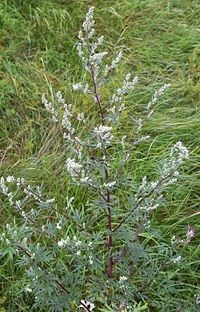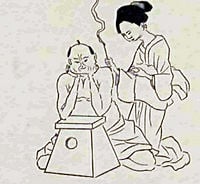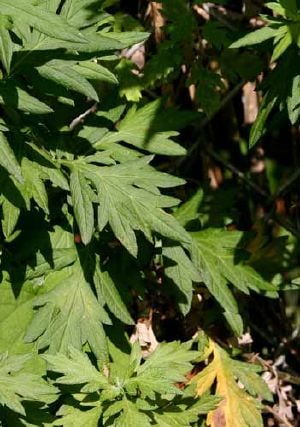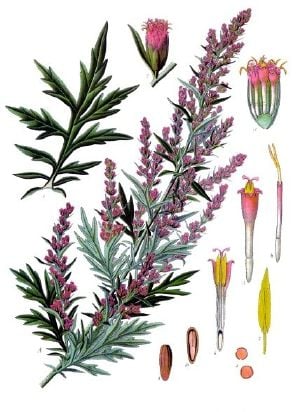Difference between revisions of "Moxa treatment" - New World Encyclopedia
Rick Swarts (talk | contribs) |
Rick Swarts (talk | contribs) |
||
| Line 1: | Line 1: | ||
{{Claimed}}{{Contracted}} | {{Claimed}}{{Contracted}} | ||
[[Image:A Dose of Moxa.jpg|thumb|200px|Moxibustion]] | [[Image:A Dose of Moxa.jpg|thumb|200px|Moxibustion]] | ||
| − | '''Moxibustion''' ({{zh-cp|c=[[wikt:灸|灸]]|p=jiǔ}}) is an [[oriental medicine]] therapy | + | '''Moxibustion''' ({{zh-cp|c=[[wikt:灸|灸]]|p=jiǔ}}) or '''moxa treatment''' is an [[oriental medicine]] therapy involving the burning of ''moxa'' or [[mugwort]] [[herb]] (''Artemisia vulgaris'') close to the skin to treat [[disease]]s or produce analgesia (pain relief). Moxibustion may also utilize wormwood or other combustible and slow-burning substance. The purpose is to strengthen and stimulate the [[blood]] and ''qi'' (life energy) of the body. |
| + | |||
| + | Moxibustion plays an important role in the traditional [[medicine|medical]] systems of [[China]], [[Japan]], [[Korea]], [[Vietnam]], [[Tibet]], and [[Mongolia]]. The basic technique involves placing burning mugwort over the affected area on the body, particularly on an [[acupuncture]] point, and removing it before burning the skin (Kim 2001). Suppliers usually age the mugwort and grind it up to a fluff; practitioners burn the fluff or process it further into a stick or cone that may resemble a (non-smokable) [[cigar]]. They can use it indirectly, with [[acupuncture]] needles, or sometimes burn it on a patient's skin. | ||
| + | |||
| + | Moxibustion has been show to have success in ..... | ||
==Mugwort== | ==Mugwort== | ||
| Line 21: | Line 25: | ||
}} | }} | ||
| − | ''''' | + | '''Mugwort''' is a tall, [[herb|herbaceous]] [[plant]], '''''Artemisia vulgaris''''', that is native to temperate [[Europe]], [[Asia]], and northern [[Africa]], as well present in [[North America]]. It is also known as ''wild wormwood'', ''felon herb'', ''chrysanthemum weed'', and ''St. John's plant'' (not to be confused with [[St John's wort]]). It is called ''Mogusa'' or ''Yomogi'' in Japan. Mugwort is one of several species in the genus ''[[Artemisia (plant)|Artemisia]]'' with names containing mugwort. It is a very common plant growing on nitrogenous soils, like weedy and uncultivated areas, such as waste places and roadsides. |
| − | Mugwort is a different species from | + | Mugwort is a different species from wormwood (''Artemisia absinthium'', or absinth wormwood) although several species in the ''Artemisia'' genus have the common name of wormwood), and even mugwort is sometimes called common wormwood. Mugwort is distinguished from some plants called wormwood by the leaves of mugwort being white on the under-surfaces only and by the leaf segments being pointed, not blunt. |
| − | + | [[Image:Detail of mugwort mature leaf.jpg|left|thumbnail|A mugwort leaf with the pointed leaves characteristic of a mature plant]] | |
| + | Mugwort grows about one to two meters in height (rarely 2.5 meters), with a woody root. The [[leaf|leaves]] are 5-20 centimeters long, dark green, pinnate, and with dense white [[tomentose]] hairs on the underside. The erect stem often has a red-purplish tinge. The rather small flowers (5 millimeters long) are radially symmetrical with many yellow or dark red petals. The narrow and numerous capitula (flower heads) spread out in racemose [[panicles]]. It flowers from July to September. | ||
| − | A | + | Chinese mugwort (''A. verlotiorum'') is often confused with common mugwort (''A. vulgaris''). It has oblong reddish to brown capitula, its stems are green, and the leaves broader, lighter colored, and more dense on the stem. The plant has a stronger and more pleasant smell than that of the common mugwort (whose aroma is really light). It flowers very late in the summer, but reproduces mainly by [[stolons]], thus forming thick groups. Chinese mugwort shares the same habitat as common mugwort and both are very common. |
| − | |||
| − | |||
| − | |||
| − | |||
| − | |||
| − | |||
| − | |||
| − | |||
| − | |||
| − | |||
| − | |||
| − | |||
| − | |||
| − | |||
| − | |||
| − | |||
[[Image:Koeh-016.jpg|thumb|right|19th century illustration]] | [[Image:Koeh-016.jpg|thumb|right|19th century illustration]] | ||
| − | + | The leaves and buds, best picked shortly before the plant flowers in July to September, were used as a bitter flavoring agent to season fat meat and fish. In [[Germany]], known as Beifuß, it is mainly used to season goose, especially the roast goose traditionally eaten for [[Christmas]]. Mugwort is also used in Korea and Japan to give festive [[rice cakes]] a greenish color. It is a common seasoning in Korean soups and pancakes. Known as a blood cleanser, it is believed to have different medicinal properties depending on the region it is collected. In the [[Middle Ages]] Mugwort was used as part of a herbal mixture called [[gruit]], used in the flavoring of [[beer]] before the widespread introduction of [[hop (plant)|hops]]. | |
| − | + | However, mMugwort contains [[thujone]], which is toxic. Pregnant women, in particular, should avoid consuming large amounts of mugwort. | |
| − | |||
| − | + | In addition to consumption and being used in the pulverized and aged form in moxibustion, mugwort is also used medicinally in other ways. The plant contains ethereal oils (such as [[cineole]], or wormwood oil, and [[thujone]]), [[flavonoid]]s, [[terpene|triterpenes]], and [[coumarin]] derivatives. Chewing some leaves is believe to relieve fatigue and stimulate the [[nervous system]]. It was also used as an [[anthelminthic]], so it is sometimes confused with wormwood ([[Absinth Wormwood|''Artemisia absinthium'']]). | |
| − | |||
| − | |||
| − | |||
| − | |||
| − | |||
| − | |||
| − | |||
| − | |||
| − | |||
In the Middle Ages, mugwort was used as a magical protective herb. Mugwort was used to repel insects, especially moths, from gardens. Mugwort has also been used from ancient times as a remedy against fatigue and to protect travelers against evil spirits and wild animals. Roman soldiers put mugwort in their sandals to protect their feet against fatigue. | In the Middle Ages, mugwort was used as a magical protective herb. Mugwort was used to repel insects, especially moths, from gardens. Mugwort has also been used from ancient times as a remedy against fatigue and to protect travelers against evil spirits and wild animals. Roman soldiers put mugwort in their sandals to protect their feet against fatigue. | ||
| − | Much used in witchcraft, mugwort is said to be useful in inducing [[lucid dreaming]] and [[astral travel]]. Consumption of the plant, or a [[tincture]] thereof, prior to sleeping is said to increase the intensity of dreams, the level of control, and to aid in the recall of dreams upon waking. One common method of ingestion is to smoke the plant. | + | Much used in witchcraft, mugwort is said to be useful in inducing [[lucid dreaming]] and [[astral travel]]. Consumption of the plant, or a [[tincture]] thereof, prior to sleeping is said to increase the intensity of dreams, the level of control, and to aid in the recall of dreams upon waking. One common method of ingestion is to smoke the plant. |
| − | |||
== Terminology == | == Terminology == | ||
| Line 84: | Line 62: | ||
Practitioners may use acupuncture needles made of various materials in combination with moxa, depending on the direction of qi flow they wish to stimulate. | Practitioners may use acupuncture needles made of various materials in combination with moxa, depending on the direction of qi flow they wish to stimulate. | ||
| + | |||
| + | The British RCT yielded results that indicate that [[moxibustion]] of mugwort was indeed effective at increasing the cephalic positioning of fetuses who were in a [[breech birth|breech position]] before the intervention. Since it also causes uterine contractions, it has been used to cause abortion. It also plays a role in Asian traditional medicine as a method of correcting breech presentation. This method is termed [[moxibustion]]. A study of 260 Chinese women at 33 weeks of pregnancy demonstrated cephalic version within two weeks in 75% of fetuses carried by patients who were treated with moxibustion, as opposed to 48% in the control group.<ref>Cardini, F., and W. X. Huang. JAMA 280(18): 1580-1584, November 1998</ref> It has also been shown that acupuncture plus moxibustion slows fetal heart rates while increasing fetal movement.<ref>Neri, I., et al. Journal of the Society for Gynecological Investigation 9(3): 158-162, May-June 2002</ref> Two recent studies of Italian patients produced conflicting results. In the first, involving 226 patients, there was cephalic presentation at delivery in 54% of women treated between 33 and 35 weeks with acupuncture and moxibustion, vs. 37% in the control group.<ref>Neri, I., et al. Journal of Maternal-Fetal and Neonatal Medicine 15(4): 247-252</ref> The second was terminated prematurely because of numerous treatment interruptions.<ref>Cardini, F., et al. BJOG 112(6): 743-747, June 2005</ref> | ||
== Parallel uses of mugwort == | == Parallel uses of mugwort == | ||
Revision as of 21:34, 17 December 2007
Moxibustion (Chinese: 灸; pinyin: jiǔ) or moxa treatment is an oriental medicine therapy involving the burning of moxa or mugwort herb (Artemisia vulgaris) close to the skin to treat diseases or produce analgesia (pain relief). Moxibustion may also utilize wormwood or other combustible and slow-burning substance. The purpose is to strengthen and stimulate the blood and qi (life energy) of the body.
Moxibustion plays an important role in the traditional medical systems of China, Japan, Korea, Vietnam, Tibet, and Mongolia. The basic technique involves placing burning mugwort over the affected area on the body, particularly on an acupuncture point, and removing it before burning the skin (Kim 2001). Suppliers usually age the mugwort and grind it up to a fluff; practitioners burn the fluff or process it further into a stick or cone that may resemble a (non-smokable) cigar. They can use it indirectly, with acupuncture needles, or sometimes burn it on a patient's skin.
Moxibustion has been show to have success in .....
Mugwort
| Mugwort | ||||||||||||||
|---|---|---|---|---|---|---|---|---|---|---|---|---|---|---|
 | ||||||||||||||
| Scientific classification | ||||||||||||||
| ||||||||||||||
| Artemisia vulgaris L. |
Mugwort is a tall, herbaceous plant, Artemisia vulgaris, that is native to temperate Europe, Asia, and northern Africa, as well present in North America. It is also known as wild wormwood, felon herb, chrysanthemum weed, and St. John's plant (not to be confused with St John's wort). It is called Mogusa or Yomogi in Japan. Mugwort is one of several species in the genus Artemisia with names containing mugwort. It is a very common plant growing on nitrogenous soils, like weedy and uncultivated areas, such as waste places and roadsides.
Mugwort is a different species from wormwood (Artemisia absinthium, or absinth wormwood) although several species in the Artemisia genus have the common name of wormwood), and even mugwort is sometimes called common wormwood. Mugwort is distinguished from some plants called wormwood by the leaves of mugwort being white on the under-surfaces only and by the leaf segments being pointed, not blunt.
Mugwort grows about one to two meters in height (rarely 2.5 meters), with a woody root. The leaves are 5-20 centimeters long, dark green, pinnate, and with dense white tomentose hairs on the underside. The erect stem often has a red-purplish tinge. The rather small flowers (5 millimeters long) are radially symmetrical with many yellow or dark red petals. The narrow and numerous capitula (flower heads) spread out in racemose panicles. It flowers from July to September.
Chinese mugwort (A. verlotiorum) is often confused with common mugwort (A. vulgaris). It has oblong reddish to brown capitula, its stems are green, and the leaves broader, lighter colored, and more dense on the stem. The plant has a stronger and more pleasant smell than that of the common mugwort (whose aroma is really light). It flowers very late in the summer, but reproduces mainly by stolons, thus forming thick groups. Chinese mugwort shares the same habitat as common mugwort and both are very common.
The leaves and buds, best picked shortly before the plant flowers in July to September, were used as a bitter flavoring agent to season fat meat and fish. In Germany, known as Beifuß, it is mainly used to season goose, especially the roast goose traditionally eaten for Christmas. Mugwort is also used in Korea and Japan to give festive rice cakes a greenish color. It is a common seasoning in Korean soups and pancakes. Known as a blood cleanser, it is believed to have different medicinal properties depending on the region it is collected. In the Middle Ages Mugwort was used as part of a herbal mixture called gruit, used in the flavoring of beer before the widespread introduction of hops.
However, mMugwort contains thujone, which is toxic. Pregnant women, in particular, should avoid consuming large amounts of mugwort.
In addition to consumption and being used in the pulverized and aged form in moxibustion, mugwort is also used medicinally in other ways. The plant contains ethereal oils (such as cineole, or wormwood oil, and thujone), flavonoids, triterpenes, and coumarin derivatives. Chewing some leaves is believe to relieve fatigue and stimulate the nervous system. It was also used as an anthelminthic, so it is sometimes confused with wormwood (Artemisia absinthium).
In the Middle Ages, mugwort was used as a magical protective herb. Mugwort was used to repel insects, especially moths, from gardens. Mugwort has also been used from ancient times as a remedy against fatigue and to protect travelers against evil spirits and wild animals. Roman soldiers put mugwort in their sandals to protect their feet against fatigue.
Much used in witchcraft, mugwort is said to be useful in inducing lucid dreaming and astral travel. Consumption of the plant, or a tincture thereof, prior to sleeping is said to increase the intensity of dreams, the level of control, and to aid in the recall of dreams upon waking. One common method of ingestion is to smoke the plant.
Terminology
The word "moxa" comes from Japanese mogusa (艾) (the u is not very strongly enunciated). Yomogi (蓬) also serves as a synonym for moxa in Japan. Chinese uses the same character as mogusa, but pronounced differently: ài, also called àiróng (艾絨)(meaning "velvet of ài").
The Chinese character for moxa forms one half of the two making up the Chinese word that often gets translated as "acupuncture" zhēnjiǔ (鍼灸).
Theory and practice
Practitioners use moxa to warm regions and acupuncture points with the intention of stimulating circulation through the points and inducing a smoother flow of blood and qi. Research, for example at Mugwort (Encyclopedia of Alternative Medicine by Clare Hanrahan) has shown that mugwort acts as an emmenagogue, meaning that it stimulates blood-flow in the pelvic area and uterus. It is claimed that moxibustion militates against cold and dampness in the body and can serve to turn breech babies [1]
Medical historians believe that moxibustion pre-dated acupuncture, and needling came to supplement moxa after the 2nd century B.C.E. Different schools of acupuncture use moxa in varying degrees. For example a 5-element acupuncturist will use moxa directly on the skin, whilst a TCM-style practitioner will use rolls of moxa and hold them over the point treated. It can also be burnt atop a fine slice of ginger root to prevent scarring.[citation needed]
Practitioners consider moxibustion to be especially effective in the treatment of chronic problems, "deficient conditions" (weakness), and gerontology. Bian Que (fl. circa 500 B.C.E.), one of the most famous semi-legendary doctors of Chinese antiquity and the first specialist in moxibustion, discussed the benefits of moxa over acupuncture in his classic work. He asserted that moxa could add new energy to the body and could treat both excess and deficient conditions. On the other hand, he advised against the use of acupuncture in an already deficient (weak) patient, on the grounds that needle manipulation would leak too much energy.
A huge classical work, Gao Huang Shu (膏肓俞), specialises solely in treatment indications for moxa on a single point (穴).
Note that Taoists use scarring moxibustion along with Chinese medical astrology for longevity.
Practitioners may use acupuncture needles made of various materials in combination with moxa, depending on the direction of qi flow they wish to stimulate.
The British RCT yielded results that indicate that moxibustion of mugwort was indeed effective at increasing the cephalic positioning of fetuses who were in a breech position before the intervention. Since it also causes uterine contractions, it has been used to cause abortion. It also plays a role in Asian traditional medicine as a method of correcting breech presentation. This method is termed moxibustion. A study of 260 Chinese women at 33 weeks of pregnancy demonstrated cephalic version within two weeks in 75% of fetuses carried by patients who were treated with moxibustion, as opposed to 48% in the control group.[2] It has also been shown that acupuncture plus moxibustion slows fetal heart rates while increasing fetal movement.[3] Two recent studies of Italian patients produced conflicting results. In the first, involving 226 patients, there was cephalic presentation at delivery in 54% of women treated between 33 and 35 weeks with acupuncture and moxibustion, vs. 37% in the control group.[4] The second was terminated prematurely because of numerous treatment interruptions.[5]
Parallel uses of mugwort
In North and South America, indigenous peoples regard mugwort as a sacred plant of divination and spiritual healing, as well as a panacea. Mugwort amongst other herbs were often bound into smudge sticks. Europeans placed sprigs of mugwort under pillows to provoke dreams; and the herb had associations with the practice of magic in Anglo-Saxon times.
ReferencesISBN links support NWE through referral fees
- ↑ http://findarticles.com/p/articles/mi_m0HKP/is_1_29/ai_73711259 American Journal of Chinese Medicine, Winter, 2001, Yoichi Kanakura, et al.
- ↑ Cardini, F., and W. X. Huang. JAMA 280(18): 1580-1584, November 1998
- ↑ Neri, I., et al. Journal of the Society for Gynecological Investigation 9(3): 158-162, May-June 2002
- ↑ Neri, I., et al. Journal of Maternal-Fetal and Neonatal Medicine 15(4): 247-252
- ↑ Cardini, F., et al. BJOG 112(6): 743-747, June 2005
See also
- Traditional Chinese medicine
- Traditional Japanese medicine (Kampo)
- Traditional Korean medicine
- Traditional Tibetan medicine
- Traditional Mongolian medicine
External links
Credits
New World Encyclopedia writers and editors rewrote and completed the Wikipedia article in accordance with New World Encyclopedia standards. This article abides by terms of the Creative Commons CC-by-sa 3.0 License (CC-by-sa), which may be used and disseminated with proper attribution. Credit is due under the terms of this license that can reference both the New World Encyclopedia contributors and the selfless volunteer contributors of the Wikimedia Foundation. To cite this article click here for a list of acceptable citing formats.The history of earlier contributions by wikipedians is accessible to researchers here:
The history of this article since it was imported to New World Encyclopedia:
Note: Some restrictions may apply to use of individual images which are separately licensed.


